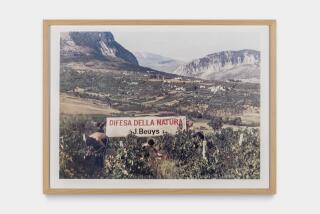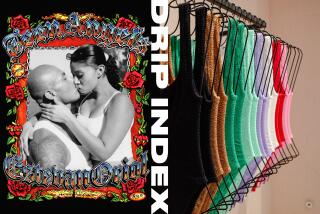Getty gets archives of the Kitchen, a leading NYC arts incubator
“Hey, babe, take a walk on the wild side” has served as a pithy invitation to explore Manhattan’s avant-garde arts scene since 1972, when Lou Reed had a hit record intoning the refrain.
But “take a tram ride up a Los Angeles hillside” seems increasingly like the most useful advice for scholars and curators interested in delving deeply into the history of the New York arts underground.
The Getty Research Institute announced Thursday that it is absorbing yet another chunk of New York City’s experimental-arts patrimony: a huge archive documenting the first three decades of work created at the Kitchen, a space in lower Manhattan that since 1971 has been a leading incubator of new developments in visual art, performance art, and contemporary music and dance.
PHOTOS: Best art moments of 2013 | Christopher Knight
Materials from the Kitchen began arriving at the Getty this week, with more shipments to come over the next two years. The acquisition – for an undisclosed sum paid to the still-busy Kitchen -- includes 5,410 videotapes, more than 600 audio recordings, 246 original posters and enough photographs and papers to occupy 131 feet of shelf space.
“Many prominent artists created their most formative and influential work at the Kitchen,” said the Getty’s written announcement of the acquisition, which went on to present a long list that includes Laurie Anderson, Karole Armitage, John Cage, Merce Cunningham, Philip Glass, Karen Finley, Mike Kelley, Bill T. Jones, Robert Mapplethorpe, Christian Marclay, Nam June Paik, Cindy Sherman, Bill Viola and Robert Wilson, “among many others.”
Those “others” in the mixture of established and emerging figures seen at the Kitchen from 1971 through 1999, the years the Getty’s material covers, include Eric Bogosian, Trisha Brown, Richard Foreman, Tim Miller, Meredith Monk and the Wooster Group on the dance and performance side, visual artist Barbara Kruger, and Glenn Branca, Brian Eno, Steve Reich and John Zorn among the musicians. The Beastie Boys, Fab 5 Freddy, Sonic Youth and Talking Heads were among the emerging pop music acts who stepped into the Kitchen’s mix during the archived era.
PHOTOS: Faces to watch 2014 | Art
“This is one of the best performance collections in the world,” said Glenn Phillips, the Getty Research Institute curator who has overseen the acquisition. “They were showing some of the best dancers and musicians and experimental artists from multiple genres, and documented just about everything that happened. I don’t know anything like it, such a complete record that’s so uniformly excellent.”
The remarkable thing, he said, is that while archives of experimental arts venues typically reflect a brief hot streak, this one extends through decades.
The Kitchen’s diversity can readily be seen in its programming ledger, Phillips said. On May 5, 1972, it presented the New York Dolls, legendary for their influence on glam rock, punk rock and the deployment of androgyny as a pop gesture. The following evening the Kitchen offered computer-generated works by artists who’d been using equipment from Bell Laboratories.
On the video art side, Phillips said, tapes from the Kitchen, which began as a showcase for experimental video artists, but soon branched into other genres, will complement the trove of more than 3,000 videotapes the Getty received in 2005 from the Long Beach Museum of Art, which could no longer afford storage and upkeep of one of the world’s first museum collections of video art.
ART: Can you guess the high price?
Re-housing the history of a relatively low-budget Manhattan arts cradle such as the Kitchen at the palatial Getty Center has its paradoxical side, acknowledged Phillips and Tim Griffin, the Kitchen’s director.
“I don’t think Mr. Getty would have set foot inside the Kitchen,” Phillips said of the oil tycoon who died in 1976, leaving a bequest that turned the J. Paul Getty Trust into the world’s richest visual art institution. Getty’s own taste in art ran to Greek and Roman antiquities, Old Master paintings and French decorative arts from the 1600s and 1700s. “In a way the [Kitchen] artists are having the last laugh here.”
Leaving aside such ironies, the Getty curator and Kitchen director say it makes a great deal of practical sense to place the Kitchen’s patrimony with the Getty -- which had a $5.34-billion investment portfolio in mid-2012, a figure that probably has benefited considerably from the long stock market surge that has lifted the S&P 500 index 35% since then.
They said the record of the Kitchen’s activities through 1999 will now reside alongside strong complementary Getty holdings, making the Kitchen material even more readily useful to scholars tracing the development of individual artists or broader themes and movements.
PHOTOS: Arts and culture in pictures by The Times
Unlike the Kitchen, where annual budgets typically have been less than $2 million and none of the dozen full-time staff members focus exclusively on what’s in the vaults, the Getty, which spent $278.6 million in 2011-12, has the resources to give the archive optimal care and boost its accessibility by more easily expediting loans to other institutions that may want to borrow videos, recordings, photographs and papers for their exhibitions.
Phillips said the Getty’s first task will be cataloging all the new material so researchers can easily find what they’re looking for. “I can say with a pretty high degree of certainty we’ll be exhibiting, presenting and potentially publishing the material,” he said, but “it’s too early to say” what the specific approaches might be.
In building its holdings documenting experimental art since the 1950s, Phillips said, the Getty is preserving for posterity creations that tend to be physically vulnerable or ephemeral by nature, and that are generally in less demand by the collectors museums typically rely on to provide them as loans or gifts.
“We feel the freedom and maybe even the duty to focus on this kind of artwork, a strand of the avant-garde that hadn’t been absorbed into the market,” Phillips said.
CRITICS’ PICKS: What to watch, where to go, what to eat
The Getty Research Institute’s documentation of New York City as an experimental arts hub dates from 1985, Phillips said, when it acquired an important archive pertaining to Fluxus, an international but New York-centric movement established in 1959.
Yoko Ono is one of the most famous Fluxus figures. Other Getty holdings that dovetail with the Kitchen material include the archive of Allan Kaprow, who, before coming to Southern California to teach at CalArts and UC San Diego, had instigated art “happenings” in New York beginning in 1959 that influenced the subsequent direction of the avant-garde.
L.A. became the leading center for the study and display of New York City photographer Robert Mapplethorpe’s work in 2011, when the Robert Mapplethorpe Foundation sent a trove of documents and photographs to the Getty and the Los Angeles County Museum of Art – partly as a donation, but with some payment in return. Mapplethorpe’s archives reside at the Getty Research Institute, and the two museums jointly own more than 2,000 photographs and other artworks.
The Getty placed a $13.57 million value on the donated materials it received from the Mapplethorpe Foundation, according to its federal tax return for 2011-12.
The Getty and the Kitchen declined to say how much money is involved in the latest New York to L.A. transfer, but Griffin, the Kitchen director, downplayed the financial aspect, characterizing it as something other than an outright sale.
He said the sum received will help compensate the Kitchen for work done over the past 10 years to put the archive in order and make digital transfers to preserve the artistry embedded in fragile analog tapes.
The Kitchen’s quarters in Manhattan’s Chelsea district can house only a fraction of the archive along with its gallery and theater, Griffin said; most has been stored elsewhere and therefore can’t be at researchers’ fingertips. That won’t be a problem at the Getty, where Phillips said everything will be on-site.
Griffin acknowledged that some New Yorkers may complain about the Kitchen’s archive going to L.A., but if they do, “the thing I can say, and I think everyone at the Kitchen can say confidently, is that we are a place committed to the artist, and the artists are really well served by this. [At the Getty] their materials will be preserved and infinitely more accessible than we or probably any other institution could have done. As an archive junkie, seeing them leave our home is not easy, but it’s definitely the best thing. The Getty’s facilities are just phenomenal.”
RELATED: More art & museums coverage by The Times
Griffin said that it was important that two artists on the Kitchen’s board, Laurie Anderson in the performance field and video artist Molly Davies, strongly approved of the archive’s transfer.
In the written announcement of the Getty’s acquisition, Anderson described the L.A.-bound materials as “the dynamic record of the reshaping of the New York world of experimental, electronic and live art, and now this remarkable reshaping can be seen and understood in a new historical light.”
Griffin said artists the Kitchen works with now will benefit indirectly as well: Having handed off custody of its 20th century history, he said, the organization can focus that much more intensely on the 21st century creativity it’s shepherding because its to-do list will no longer include handling archival requests from researchers or potential borrowers.
But the Getty’s Phillips said the deal does not divorce the Kitchen from its history. The New York organization retains the right to use the materials for exhibitions, he said, and it can continue releasing musical performances recorded at the Kitchen in its ongoing series of commercial CD releases.
PHOTOS: Best art moments of 2013 | Christopher Knight
The Kitchen director and Getty curator both think that increased scholarly perusal of the images, recordings and documents at the Getty will lead to fresh discoveries and insights about what went down at the Kitchen over the years.
“I can’t help thinking there are going to be some surprises,” Griffin said. “You have tapes that may be 25 minutes long, but [archivists and curators] only see them long enough to identify them. Who knows what you might find?”
“It’s guaranteed to happen,” Phillips said. “Scholars find remarkable things that no one ever knew was in a collection. It certainly has been that way with the Long Beach [video] archive.”
Among the nuggets in the archive, Phillips said, are a letter from the then-emerging emerging L.A. artist, Mike Kelley, who delivered a performance piece called “The Parasite Lilly” at the Kitchen in 1980. Now regarded as an essential figure in L.A.’s contemporary art movement, with a touring retrospective that will arrive March 31 at the Museum of Contemporary Art, Kelley back then felt he might be in the wrong place, and asked staffers at the Kitchen if they knew of possible day jobs that could sustain him if he moved to New York.
“He’s saying, ‘I’m just not sure L.A. is a city an artist can live in.… I want to move because I just don’t think L.A. is the city for me,’” Phillips said. “We know how that story turned out, and we’re glad he stayed in L.A.’”
ALSO:
LACMA, Getty to share Robert Mapplethorpe artwork
Getty makes thousands of images available for public use
Pacific Standard Time exhibitions changed a cultural stereotype
More to Read
The biggest entertainment stories
Get our big stories about Hollywood, film, television, music, arts, culture and more right in your inbox as soon as they publish.
You may occasionally receive promotional content from the Los Angeles Times.











